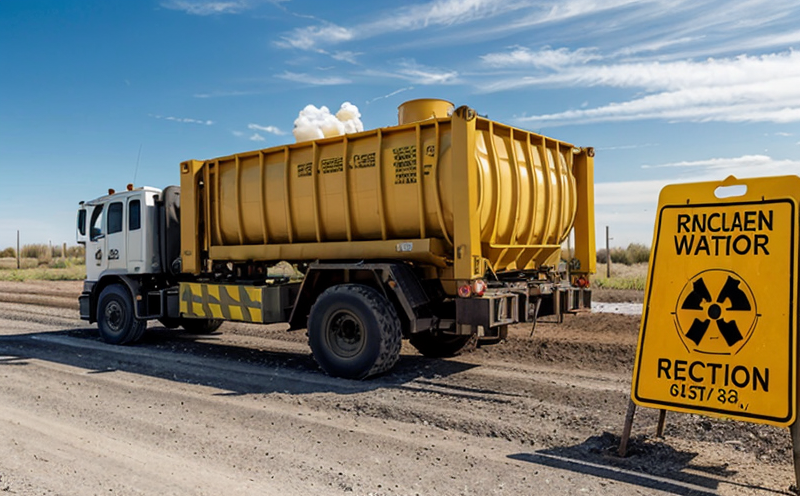ISO 9698 Tritium in Aqueous Radioactive Waste Samples
The analysis of tritium in aqueous radioactive waste samples using ISO 9698 is a critical step towards ensuring the safe management and disposal of nuclear waste. This method provides reliable quantitative data, which is essential for regulatory compliance and environmental protection.
Tritium, being one of the most common radioisotopes found in nuclear waste, poses significant health risks if not properly managed. Accurate measurement is therefore paramount to prevent accidental exposure during transportation, storage, and final disposal. The ISO 9698 standard offers a robust framework for determining tritium concentrations in aqueous samples, ensuring consistency across different laboratories.
The process begins with the collection of representative waste samples, which are then prepared using standardized techniques. This involves dilution to ensure that the concentration falls within the linear range of the analytical method used. The sample preparation also includes filtration and acidification steps, tailored specifically for tritium analysis.
After preparation, the samples undergo a series of chemical separations aimed at isolating tritium from other isotopes present in the aqueous matrix. This step is crucial as it ensures that only tritium contributes to the final measurement. The purified sample is then ready for analysis using liquid scintillation counting (LSC), a technique widely recognized for its precision and reliability.
The use of LSC enables the detection of tritium down to extremely low levels, typically in the picocurie per liter range. This sensitivity is crucial for monitoring compliance with stringent regulatory standards such as those set by international bodies like the International Atomic Energy Agency (IAEA). The method also allows for the differentiation between tritium from natural sources and that produced during nuclear processes.
The results obtained through ISO 9698 are used to assess the overall radioactivity of waste streams, which is vital for planning disposal strategies. This information helps in categorizing waste into appropriate classes (Class I, II, or III) based on its level of radioactivity. Accurate classification ensures that waste is handled and disposed of in a manner consistent with local and international regulations.
The standard also emphasizes the importance of quality assurance and control throughout the entire analytical process. This includes the use of reference materials to calibrate instruments and verify method performance, as well as the implementation of statistical techniques for data analysis. These measures ensure that the reported tritium concentrations are both accurate and reproducible.
Furthermore, ISO 9698 provides guidelines on how to handle and store radioactive waste samples to minimize radiation exposure risks. Proper handling procedures not only protect laboratory personnel but also contribute to a safer environment for all involved in the nuclear industry.
The widespread adoption of this standard by regulatory authorities and nuclear facilities underscores its importance in ensuring safe and effective management of tritium in radioactive waste. By adhering to ISO 9698, organizations can demonstrate their commitment to environmental stewardship and public safety.
Why It Matters
The accurate measurement of tritium in aqueous radioactive waste samples is crucial for several reasons:
- Regulatory Compliance: Ensures that nuclear facilities comply with stringent regulatory standards set by bodies like the IAEA and national governments.
- Environmental Protection: Helps in minimizing the release of tritium into the environment, safeguarding both human health and ecosystems.
- Risk Management: Provides essential data for assessing potential risks associated with radioactive waste disposal.
- Data Integrity: Ensures that the reported concentrations are accurate and reliable, which is vital for long-term planning and decision-making.
The importance of tritium measurement cannot be overstated. Accurate data not only supports regulatory compliance but also enhances public trust in nuclear facilities. By adhering to international standards such as ISO 9698, organizations can demonstrate their commitment to safety and environmental responsibility.
Moreover, the reliability of these measurements is critical for ensuring that waste is categorized correctly, leading to appropriate disposal methods. This, in turn, contributes to a safer and more sustainable nuclear industry.
Scope and Methodology
| Step | Description | Method |
|---|---|---|
| Sample Collection: | Collect representative samples from radioactive waste streams. | Dilute to appropriate concentration range for analysis. |
| Sample Preparation: | Incorporate filtration and acidification steps. | Use standardized techniques to ensure sample purity. |
| Chemical Separation: | Isolate tritium from other isotopes in the aqueous matrix. | Apply liquid scintillation counting (LSC) for accurate measurement. |
| Data Analysis: | Analyze results using statistical methods to ensure accuracy and reproducibility. | Compare with reference materials for calibration purposes. |
The ISO 9698 standard provides a comprehensive framework that ensures the reliability and consistency of tritium measurements. Each step in the process is meticulously defined, from sample collection to final data analysis, ensuring that laboratories can produce accurate and consistent results.
The use of liquid scintillation counting (LSC) is particularly important as it allows for the detection of tritium at extremely low levels. This sensitivity is critical for monitoring compliance with regulatory standards and for assessing potential risks associated with radioactive waste disposal.
Industry Applications
The measurement of tritium in aqueous radioactive waste samples finds application across various sectors, including nuclear power generation, decommissioning projects, and research facilities. Accurate tritium concentrations are essential for ensuring compliance with regulatory standards and for managing the risks associated with radioactive waste.
In nuclear power plants, the analysis of tritium helps in assessing the overall radioactivity levels within the facility. This information is crucial for planning maintenance activities and ensuring that all safety protocols are followed. During decommissioning projects, accurate measurements of tritium contribute to the safe handling and disposal of waste materials. Research facilities also rely on these measurements to ensure that their operations comply with international standards.
The use of ISO 9698 ensures consistency across different laboratories, which is particularly important in a global industry where regulatory compliance is paramount. By adhering to this standard, organizations can demonstrate their commitment to safety and environmental responsibility. This, in turn, enhances public trust and confidence in nuclear facilities.





